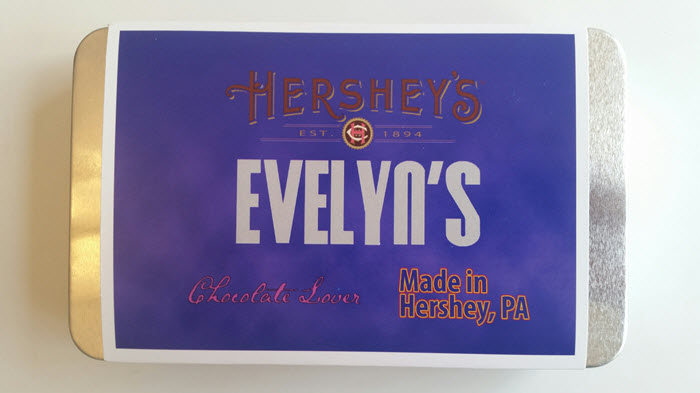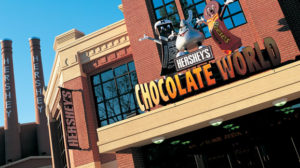When he was helping to plan our trip to Paris to celebrate my 40th birthday, he discovered that a major chocolate exhibition was going to be there at the same time. Besides sampling and purchase opportunities, there were multiple exhibits including a replica of a 17th century dress made of chocolate.
When we were planning to return to Paris in 2014 with our children, Dan found that a chocolate museum had opened in 2010. Our family spent Easter Sunday afternoon at Le Musée Gourmand Du Chocolate – Choco-Story, learning about the history of chocolate, watching a chocolate-making demonstration and, of course, tasting chocolate.
And for our vacation last April as he sought diversions for our college tour of Pennsylvania, Dan found Hershey’s Chocolate World.
The man has a gift.
Hershey’s Chocolate World (not to be confused with Hershey Park theme park) is a sprawling indoor complex. There we learned the proper method of tasting chocolate, saw a 4D chocolate mystery film, took a tour and created our own customized candy bars. We ate a meal at the food court and purchased novelties in Hershey’s largest candy store.
Hershey was not a just a brand of candy bar to us that afternoon. Hershey’s Chocolate World was a fun family experience and it became a fond vacation memory. I recall the memory often when I see the brand or the Chocolate World magnet on my refrigerator.
While companies often struggle to cram their brand message into a tagline, a tweet, a Facebook post or a 30-second TV ad, brand experiences like Hershey’s Chocolate World offer the opportunity to engage consumers in a more positive and less rushed manner. When you offer a brand experience:
- Consumers come to you. As they choose to be there, they are more open to your brand’s messages as opposed to your ads and promoted social media messages which constitute interruption marketing.
- They spend more time with your brand. Instead of 30 seconds or less, they are there to enjoy an extended experience.
- They bring friends and family. For an experience, consumers are more likely to invite company than to attend alone.
- Some become ambassadors for your brand. If they enjoy themselves, they are likely to tell others as well as share photos and comments on social media like Facebook, Twitter and Instagram. This word-of-mouth is more credible than ads or promoted posts and it is free.
Done well, brand experiences establish emotional connections to your brand and differentiate it. Moreover, with a brand experience you can see who your marketing dollars are reaching.
Now I know what you are thinking. That is a HUGE investment.
Brands in adolescence are often too early in their growth to support an on-going themed venue. But you don’t need to operate a year-round theme park to offer consumers a brand experience.
Here are tips that any brand can use to craft a successful brand experience:
- Start small. Begin with a single notable experience (a tour, a demonstration, a seminar) or a one-day event (a fashion show or relevant entertainment).
- Make it fun.
- Tell your brand’s story. Make your experience relevant to your brand and indicative of its personality.
- Resist the urge to sell. If it makes sense you can offer mementos and have some of your product available on the side, but pushing your product detracts from the experience and undermines your effort to make an emotional connection. And no, a retail store does not qualify as a brand experience in this manner.
- Be patient. Brand experiences and events take time to grow. It takes time for word to spread and for reviews to appear, and that is good. It gives you time to try different ideas and to pursue the ones that resonate most with your target audience.
I cannot emphasize enough the point about being patient. Look at the history of any conference, festival or brand event and you’ll see a humble evolution. Did you know:
- The first TED conference in 1984 lost money and it was six years until the founders tried a second time. Now it sells out to 1,400 people annually paying $7,500 each.
- The first Life is Good festival in 2003 was a pumpkin festival in Portland, Maine that raised $52,000 for children facing life-threatening challenges. Now the annual event raises more than $1,000,000 as a two-day arts and music festival in Canton, Massachusetts.
- The first Ben & Jerry’s free cone day in 1979 was established to celebrate the company’s one year anniversary and was served out of the renovated gas station that was their only store. Now they give away over a million scoops and there is no limit to the number of times you can get back in line. (Don’t ask me how I know.)
Differentiate your brand by building emotional connections with a unique brand experience. You will create an asset that grows your business and that your competitors can’t touch.
And if there is chocolate involved, please let me know.
Have you had a memorable brand experience? Delightful or disastrous? Please share it in the comments.
If you liked this post, you’ll love the next one.
To have future posts sent to your inbox...


